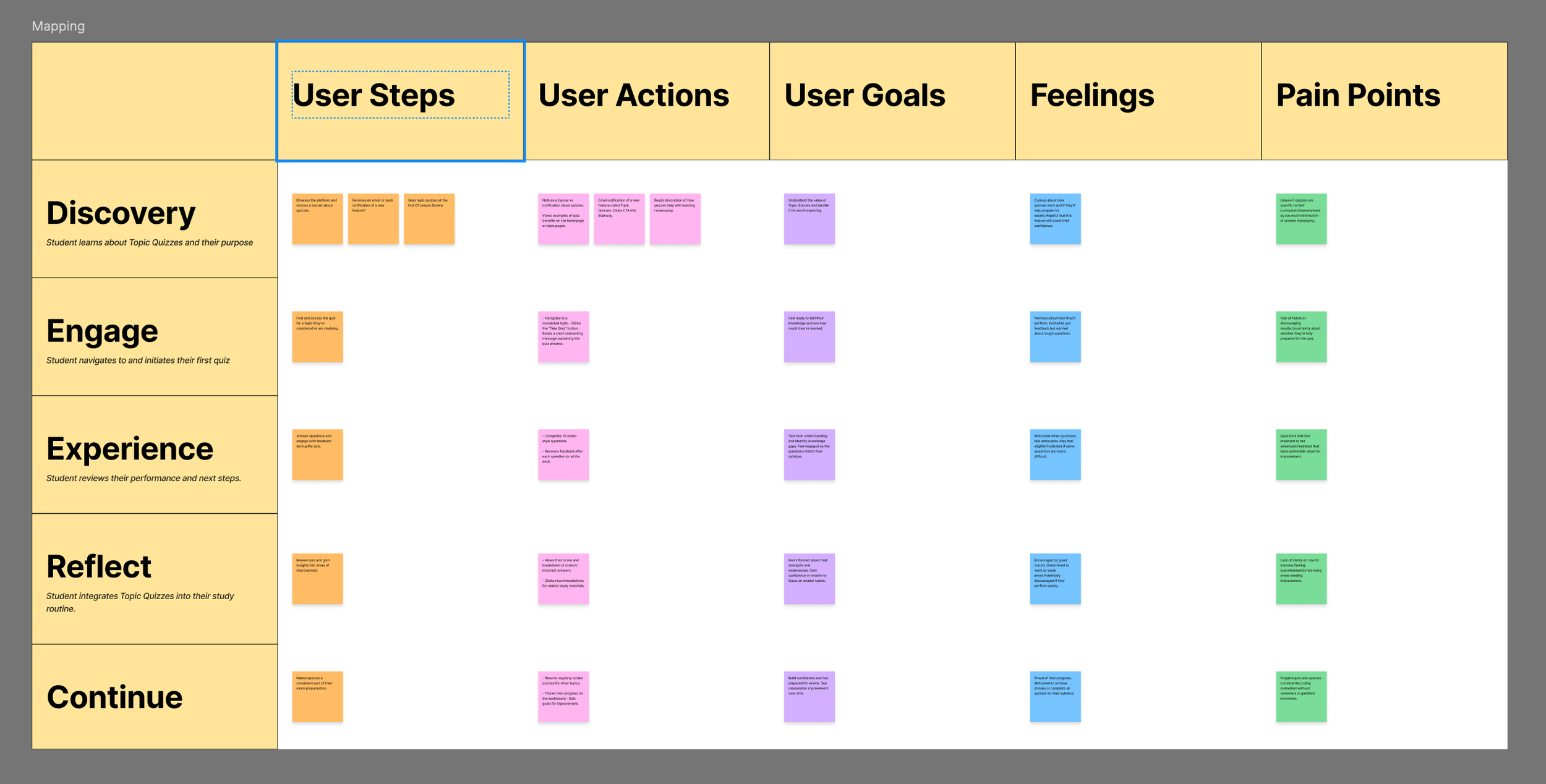
Bridging the gap between studying and exam readiness
Case study
ROLE
UX, UI, Research
DURATION
1.5 months
PLATFORM
iOS
COMPANY
Stairway
CONTEXT
For many GCSE students, revision isn’t just about memorising facts-it's about applying knowledge under exam conditions. Yet traditional revision methods often fall short. This disconnect left them feeling uncertain about their readiness and ability to perform well.
CONTRIBUTION
Led the design and release of Topic Quizzes, a feature to help students understand what to focus on.

Stairway is an online digital tutor for GCSE Maths and Science. Every GCSE student knows the pressure of exam season but how do they really revise? And more importantly, what makes it work (or not work) for them?
To find out. I ran user testing sessions with 20 students. digging into their revision habits, struggles, and what they wished was different. Here are some of the key insights:
Understanding how students learn

“I use past papers because they feel like the real exam— like the way the questions are actually written”
“It would be so much easier if I just knew what I needed to focus on”
“I switch between different websites… one for exams, one for learning, and another for tracking my syllabus”
“I tend to study a lot but it’s hard to tell if I’m actually learning”
The challenge wasn't just about providing resources. It was about making it clear what they should work on next and giving them confidence that their effort was paying off.
The product and wider team brainstormed several potential solutions to address this problem using the Crazy Eights brainstorming method. We opted to pursue Topic Quiz as the most promising solution. By integrating exam-style question formats, instant feedback, and gamification elements, Topic Quizzes aimed to help students feel confident in their exam confidence.
To ensure Topic Quizzes seamlessly fit into the student revision experience, we mapped out the user journey from discovery to engagement. This exercise allowed us to step into the student's perspective, uncovering what they were thinking, feeling, and struggling with at each stage-from landing on the homepage to starting a quiz.
Let’s create Topic Quizzes. A feature that allows learners to test their knowledge on topics by simulating exam style questions and provide feedback as to what they need to work on more.
How does a learner enter a quiz
What is the quiz experience like?
How do we recommend next steps
What is our design outcome?

Where do Topic Quizzes fit into the learning flow?
Before any topic content:
Positioning the quiz at the start of the topic would act as a pre- diagnostic tool, helping to assess prior knowledge. This could personalise the learning experience by identifying gaps early on and tailoring recommendations accordingly.
After completing all lessons:
Unlocking the quiz only after the learner had completed all lessons would allow it to function as a summative assessment tool, testing their understanding of the material and providing validation for their learning.

It was time to start wireframing the experience. Quizzes lived at topic-level which gave me confidence first to begin exploring how quizzes display within the existing screens.
To determine the optimal placement of Topic Quizzes within the learning journey, I developed a working prototype and tested it with students. This was essential to uncover whether Topic Quizzes were a pre-diagnostic tool or a summative learning tool.

Key Insights
10 of 12 students preferred topic quiz at the end of their topic learning.
4 of 12 students would have set a timer for their topic quiz.
8 of 12 struggled to find the topic quiz.
12 of 12 understood how to review their quiz after completion.
“If i guess and get it right, the quiz might think I know it, but I really don’t... I’d rather skip so it knows I need to work on that.. (lesson).”
During one of the sessions, a student paused at a question. muttering, “I think it's B. but Im' not sure." They clicked an answer based on a hunch but admitted afterward that they would have preferred to skip it if there had been a pass option. This moment unraveled a key behavior: students were more likely to guess if they had a slight inkling about the answer, but they would’ve preferred to pass if they were completely unsure. I made changes to the wireframes to reflect these new insights.
Post testing. I began to work up hi-fidelity changes from the wireframes to improve usability. The timer functionality did not test very well therefore we pushed this back into the backlog to do more research on for a potential later iteration.

40%
of active students used Topic Quizzes within the first month.
74%
of students who started a quiz completed it, showing strong engagement.
38%
of students revisited at least one lesson after recieving a quiz recommendation



